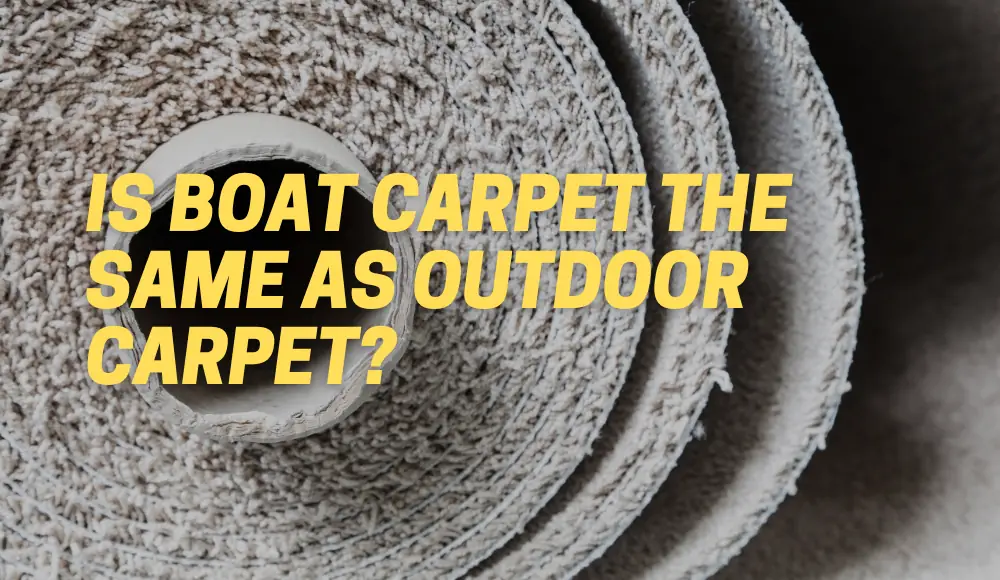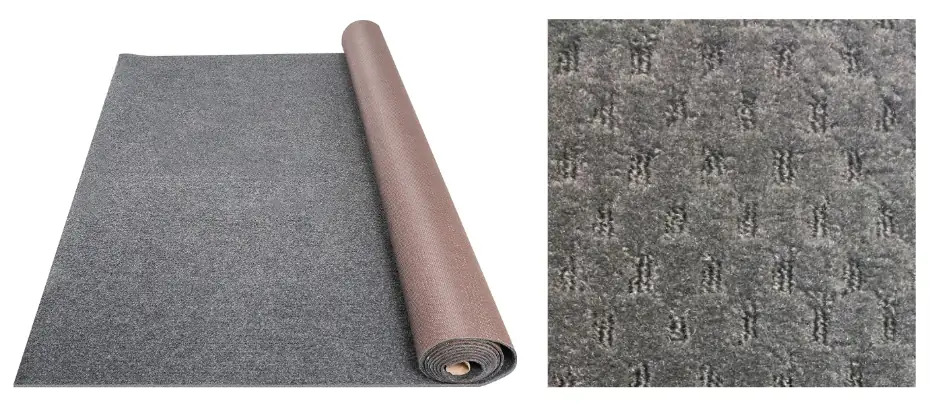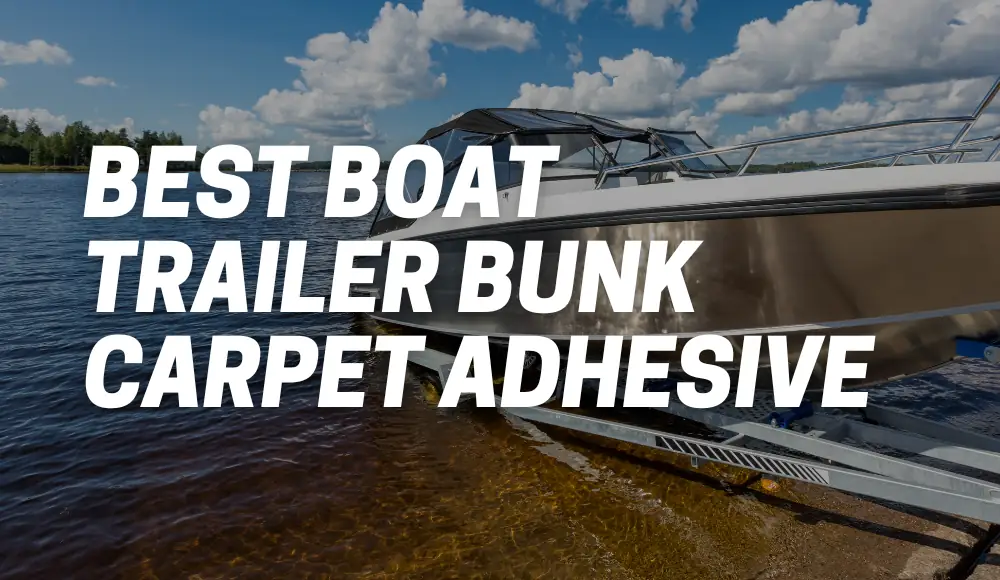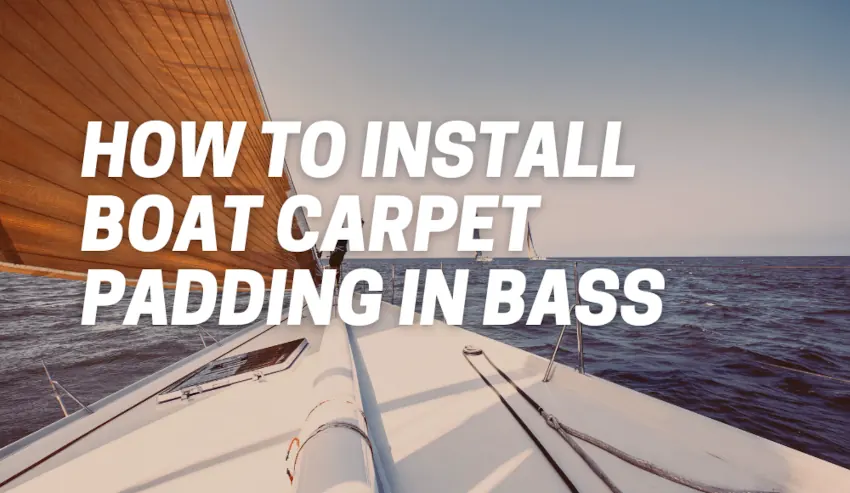If you’re a boat enthusiast, you know that maintaining the quality and appearance of your vessel is crucial. One key element of boat maintenance is the choice of flooring. When it comes to boat carpet, there are a few questions that often arise. Is boat carpet the same as outdoor carpet? Is it waterproof? How long does it last?
In this article, we will explore these questions and more, providing you with the knowledge you need to make an informed decision about your boat carpeting.
What is a Marine Carpet?
First things first.
Before diving into the details, let’s start with the basics.
What type of carpet is used on boats?
A marine carpet, also known as boat carpet, is a specialized flooring designed for use in boats and other marine vessels. Unlike regular household carpets, marine carpets are specifically engineered to withstand the harsh marine environment, including exposure to water, sunlight, and heavy foot traffic.
Is Boat Carpet Waterproof?
One of the primary concerns when it comes to boat carpet is its ability to resist water damage.
After all, boats and water go hand in hand. The good news is that most marine carpets are designed to be water-resistant or even waterproof. They are typically made from synthetic materials such as polypropylene or nylon, which have inherent water-repellent properties.
However, it’s important to note that while marine carpets can withstand occasional splashes and spills, they are not completely impervious to water.
Prolonged exposure to standing water or continuous submersion may still cause damage over time.
Is Boat Carpet the Same as Outdoor Carpet?
Many people wonder if boat carpet and outdoor carpet are interchangeable.
While they may seem similar, there are some crucial differences between the two. Boat carpet is specifically engineered for marine applications, taking into account the unique challenges of the boating environment.
On the other hand, outdoor carpet is designed for general outdoor use, such as patios or porches, and may not offer the same level of durability and water resistance as marine carpet.
Marine Carpet vs Outdoor Carpet
Materials used in making boat carpets and outdoor carpets
Boat carpet and outdoor carpet are made from different materials to suit their respective purposes. Boat carpet is usually made from synthetic materials like polypropylene, nylon, or olefin.
These materials are resistant to water and mildew, which makes them ideal for use on boats. On the other hand, outdoor carpets can be made from a range of materials including natural fibers like sisal or seagrass, as well as synthetic fibers like polyester or nylon.
Durability and resistance to water, UV rays, and other elements
What is special about marine carpet?
When it comes to durability and resistance against water and UV rays, boat carpet is designed specifically to withstand rough conditions that come with being on boats. As such, it is more durable than most outdoor carpets.
Boat carpets are also treated with special chemicals that help prevent mold growth which can be problematic in damp environments. Outdoor carpets can last a long time too but may not withstand harsh marine environments as well as boat carpet does.
Design and style options for both types of carpets
Design elements of boat carpeting usually include a nonskid backing that helps provide better traction even when wet.
This type of carpeting is often available in limited colors due to its specific function but still offers numerous design options like geometric patterns or solid colors.
Outdoor carpets have far more design options than their marine counterparts due to being used more frequently in residential settings where the style plays an important role in creating an appealing look that compliments the surrounding area outside the home.
Overall differences between boat and outdoor rugs lie within their specific purposes.
Boat rugs are built with performance in mind while outdoor rugs focus on aesthetic appeal over performance features making them suitable for patio decks etcetera away from harsh marine conditions.
How Long Does Boat Carpet Last?
The lifespan of boat carpet varies depending on several factors, including the quality of the carpet, the amount of foot traffic it receives, and how well it is maintained.
On average, a high-quality marine carpet can last anywhere from 5 to 10 years or even longer with proper care. Regular cleaning and maintenance, such as vacuuming and spot cleaning, can help extend the lifespan of your boat carpet.
Additionally, choosing a marine carpet with a higher pile density and thicker backing can contribute to its longevity.
Can Marine Carpet Get Wet?
While marine carpets are designed to resist water damage, they are not completely immune to getting wet. As mentioned earlier, marine carpets are water-resistant or waterproof to a certain extent. They can handle occasional exposure to water, such as rain or splashes from waves. However, it’s important to prevent standing water from accumulating on the carpet for extended periods, as this can lead to moisture retention, mold, and mildew growth. Proper drainage and ventilation in the boat’s flooring system are essential to prevent water from seeping into the carpet and causing damage.
Carpets for boats
What are the Pros and Cons of Marine Carpet?
To help you weigh the pros and cons of using marine carpet in your boat, let’s take a closer look at its advantages and disadvantages.
Pros:
- Durability: Marine carpets are built to withstand the rigors of the marine environment, including heavy foot traffic and exposure to the elements.
- Comfort: Boat carpet provides a comfortable surface to walk on, reducing fatigue and providing a cushioned feel underfoot.
- Noise Reduction: The carpet’s soft texture can help absorb noise and reduce vibrations, creating a quieter and more enjoyable boating experience.
- Non-Slip Properties: Many marine carpets have a textured surface that provides enhanced traction, reducing the risk of slips and falls.
Cons:
- Maintenance: Boat carpet requires regular cleaning and maintenance to prevent the buildup of dirt, debris, and moisture.
- Limited Color Options: Marine carpets often come in a limited range of colors and patterns compared to household carpets.
- Installation Challenges: Proper installation of boat carpet can be time-consuming and may require professional assistance.
- Potential for Mold and Mildew: If not properly cared for, marine carpet can be susceptible to mold and mildew growth, especially in humid conditions.
How to Choose a Boat Carpet?
When selecting a boat carpet, several factors should be taken into consideration:
- Material: Opt for marine carpets made from durable and water-resistant materials such as polypropylene or nylon.
- Backing: Look for a marine carpet with a thick and sturdy backing to provide added support and durability.
- Pile Density: Higher pile density indicates a denser and more resilient carpet, capable of withstanding heavy use and foot traffic.
- UV Resistance: Ensure that the carpet has built-in UV resistance to protect it from sun damage and fading.
- Color and Style: Choose a color and style that complements your boat’s aesthetics while considering practicality and ease of cleaning.
By considering these factors, you can find a boat carpet that meets your specific needs and preferences.
Does Boat Carpet Get Hot?
Boat owners often wonder if boat carpet can become uncomfortably hot under the sun. The answer depends on various factors, including the carpet’s color, material, and the intensity of the sunlight.
Darker-colored carpets tend to absorb more heat, while lighter-colored carpets reflect heat to a certain extent.
Additionally, some marine carpets are designed with built-in heat-resistant properties to minimize heat absorption.
However, it’s important to remember that even with these measures, boat carpets can still become warm to the touch, especially in direct sunlight. Using additional shading options or considering alternatives such as synthetic teak decking can help mitigate the heat issue.
How Thick is Marine Grade Carpet?
The thickness of marine grade carpet can vary depending on the manufacturer and specific product.
On average, marine carpets have a pile height ranging from ¼ inch to ½ inch (6 to 12 millimeters). This thickness provides a good balance between comfort and durability.
Thicker carpets offer more cushioning and comfort underfoot, while also providing better insulation and noise reduction. However, it’s important to ensure that the carpet thickness does not interfere with the boat’s overall stability or interfere with the operation of hatches or doors.
How Long Does it Take Marine Carpet to Dry?
The drying time of marine carpet depends on various factors, including the carpet’s material, thickness, and environmental conditions.
In general, marine carpets with good water-resistant properties tend to dry relatively quickly. After exposure to moisture, such as rain or cleaning, it’s important to allow the carpet to dry thoroughly to prevent the growth of mold and mildew.
Proper ventilation and airflow within the boat can help expedite the drying process. If necessary, using absorbent towels or a wet/dry vacuum can aid in removing excess moisture from the carpet.
Factors to Consider When Choosing Between Boat Carpet and Outdoor Carpet
Type of watercraft or surface where the carpet will be installed
One of the key factors to consider when choosing between boat carpet and outdoor carpet is the type of watercraft or surface where the carpet will be installed.
Boat carpets are specifically designed for use on boats, and they offer better traction on wet surfaces.
On the other hand, outdoor carpets can be used on a variety of surfaces such as patios, decks, and porches. If you are looking for a versatile option that can work in different areas, then outdoor carpet might be your best bet.
Climate conditions
Another important factor to consider is the climate conditions in your area where you plan to install your new carpet. Boat carpets are made from materials that are resistant to water damage and UV rays, making them ideal for use in areas with high humidity or exposure to sunlight.
In contrast, outdoor carpets may not hold up as well in harsh weather conditions. If you live in an area with extreme weather patterns, such as frequent storms or high winds, then boat carpets may be a better option.
Budget considerations
The final factor you’ll want to think about is budget considerations.
While boat carpets tend to be more expensive than outdoor carpets because of their specialized materials and design features that make them more durable against wear-and-tear from water exposure over time – they can also last longer which could save you money over time by not having to replace it as often.
However, if budget constraints are an issue for you but you still need a durable flooring solution, then outdoor carpets may offer a more affordable option without compromising on quality too much.
Boat carpets offer better traction on wet surfaces, while outdoor carpets are versatile enough to use in different areas.
Also, keep in mind that boat carpets tend to be more expensive but may last longer than their outdoor counterparts.
Tips on How to Properly Install Boat Carpets or Outdoor Carpets
Preparation before installation (cleaning, measuring)
Before installing boat carpets or outdoor carpets, it is important to prepare the surface properly. The best way to do this is to clean the surface thoroughly and make sure it is dry.
This will ensure that the carpet adheres properly and lasts longer. It is also important to measure the area where the carpet will be installed to ensure that you buy enough material for the job.
Tools needed for installation (adhesives, trowels)
When installing boat carpets or outdoor carpets, you will need a few tools to help you get the job done right. You will need a good adhesive that is designed for use with your particular type of carpet.
You may also need a trowel to spread the adhesive evenly over the surface. Other tools that may come in handy include a utility knife, scissors, and a straight edge.
FAQs
How do you maintain marine carpet?
Regular maintenance of marine carpet involves vacuuming to remove dirt and debris, spot-cleaning spills and stains promptly, and periodic deep cleaning with a mild carpet cleaner. It’s important to follow the manufacturer’s instructions for cleaning and maintenance to ensure the longevity of the carpet.
Is it OK to pressure wash boat carpet?
Pressure washing boat carpet is generally not recommended, as it can force water and debris deeper into the carpet fibers and potentially damage the carpet. It’s best to stick to gentle cleaning methods and avoid excessive force or high-pressure water.
Do you glue boat carpet in?
Gluing boat carpet is a common method of installation. Marine-grade adhesives are used to secure the carpet to the boat’s flooring. Proper surface preparation and following the manufacturer’s instructions for adhesive application are essential for a successful installation.
Can you vacuum marine carpet?
Yes, vacuuming marine carpet is an important part of regular maintenance. Use a vacuum with a brush attachment to remove dirt, dust, and debris from the carpet’s surface. Regular vacuuming helps maintain the carpet’s appearance and prolong its lifespan.
Conclusion
Boat carpet plays a vital role in protecting your boat’s flooring while providing comfort and aesthetic appeal.
Understanding the differences between marine carpet and outdoor carpet, along with their unique properties, can help you make an informed decision when choosing the right flooring for your boat.
By considering factors such as material, water resistance, durability, and maintenance requirements, you can select a boat carpet that suits your needs and enhances your boating experience for years to come.




